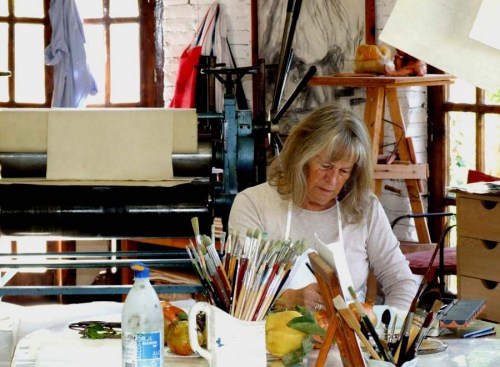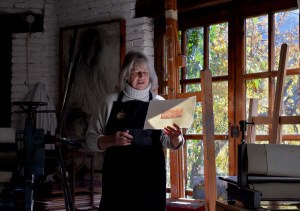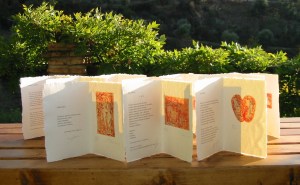And What You Can Do About It in Your Own Work
How many artists have come into my studio on the first day proclaming, “No, I’m not interested in solarplate. I’ve done it and I didn’t like the results.” Then I get out some solarplate work that I and other people have done in my studio and the negativism turn to questions. “How did you get those whites? How did you achieve those velvety blacks and the whole range of tones? These are beautiful prints!”
This happens regularly. Why? Because solarplate prints are (apparently) so quick and easy to make. You just scan or photograph an existing image (sketch, watercolor, photograph…), print it on a transparent acetate with a laser printer, sandwich it under glass with a photosensitive polymer plate, and expose it under sunshine or a UV lamp. Wash and dry it, pull a print of it on an etching press and, bingo, you’ve got a solarplate print. Well, almost. What you’ve actually got is a mediocre solarplate print. Given these results most artists never get beyond this point. It’s a shame as solarplates, when prepared with care and criteria, are capable of yielding beautiful work. With them you can either opt for positive intaglio prints using an aquatint screen, or negative relief prints without the screen.
What’s the big secret. There’s no big secret, but there a lot of little ones, and some of the most important have to do with the preparation of the acetate. It’s your all-important original. If you don’t start with a beautiful acetate you’ll never get a beautiful print. Most of the flaws in a typical solarplate print are introduced in the process of scanning. Even if you start out with an image with a proper range of tones–and no watercolor will ever clear this hurdle–the scanning processs will degrade that image. How do you recover it?
The best way is to skip the scanning/photography process altogether and create your image directly on the acetate using an opaque medium such as India ink or etching ink. You can also use lithographic ink and pencils or permanent black felt pens. This will guarantee you black blacks and brilliant whites. You’re already ahead in the game. Then you can add mid-tones to a positive plate by diluting the ink in various degrees. If you’re using Indian ink dilute with water, if it’s etching ink, with turps.
The aquatint screen, exposed first, before the image acetate, enables you to render tones in your solarplate print, similar to aquatint in an acid etching. Negative plates, similar to a woodcut or linocut, require pure blacks to highlight relief. You can use the same exposure time for the aquatint screen no matter what the light source. The area where you put the black ink will be washed out down to the steel backing leaving the unpainted areas in relief.
If you need to work from a scanned image you will have to adjust contrast in PhotoShop or other image treatment program (or take it on a pen drive to a good photocopy shop and have them do it for you) and then later by hand, working on the acetate. This means cleaning the whites with a cotton bud with a little alcohol and strengthening the black areas with opaque ink, felt pens or lithographic pencils. (NB: Be sure to use special laser acetates. If you use a normal acetate it will melt inside your printer.)
If you don’t have a vacuum exposure unit–and not many of us do–you may have trouble achieving perfect contact betweeen the plate and the acetate during exposure. This is especially important as the plates get bigger and more expensive, as you don’t want to waste many of them! To avoid this problem I add a layer of 15mm-thick foam rubber in what becomes a six-layer sandwich (from the bottom up: backing board, two felt blankets stuck to the board, a sheet of foam rubber, the plate, the acetate and the heavy-duty glass beveled on the edges). All of this I clamp firmly with six spring-loaded C-clamps.
Achieving proper exposure of a solarplate requires both art and science. People who come to printmaking from photography or science backgrounds usually emphasize the former, painters the latter. Both approaches require extensive testing. The photographers tend to do it more systematically, the painters more intuitively. Whatever your inclination, don’t be tempted to rush the exposure testing process. The success of all your solarplates from here on out will depend upon it. And don’t forget to incude the plate wash times in your tests. They are also a factor in getting quality results.(Note: The best light source for exposing solarplates is the midday sun, so you should probably move to Spain or Arizona.)
Pulling your first print from a properly prepared solarplate is a satisfying experience. If you’ve done everything right the improvement is notable. Your first proof print will not be your bon a tiré, however, and it’s still not too late to retouch your plate with a bit of drypoint. Now you enter into the thousand nuances of choosing and mixing inks and printing your plates, not to mention paper selection. I usually refer to this state as “creative printing.”
But that’s another chapter.
P.S. All of the steps in this process are easier to do than to explain. Come on over and we’ll do them together!
I almost forgot. I have made a video tutorial on this subject, available here.
.























